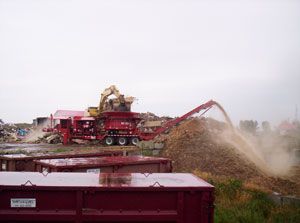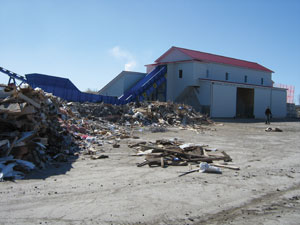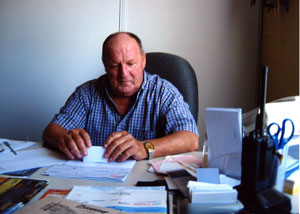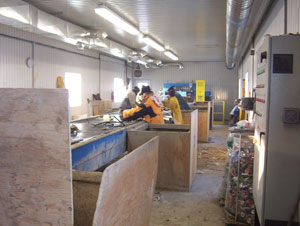
Demolition Power
December 4, 2009
By Guy Fortin
Not all that long ago, wood waste from construction and demolition
sites would have been landfilled in this part of Quebec, about 100 km
east of Montreal.
Not all that long ago, wood waste from construction and demolition sites would have been landfilled in this part of Quebec, about 100 km east of Montreal. The contaminated mix of materials had no local value. The times have certainly changed, as a number of industrial waste specialists, among them Yvon Lemay of Enfoui-Bec Inc., are now recycling the maximum volume from this one-time waste stream.

|
|
| A Komatsu 300 works off the piles of sorted waste wood, feeding the Morbark 1200 XI tub grinder. Chips go exclusively to local pulp and paper power plants.
|
For more than two years now, the company has been running a massive and dynamic sorting yard, spread across the company’s 200-ha site. With few exceptions, metal, concrete, plastic and, of course, wood from demolished buildings all find a second life here. Plastic remains the most problematic, but wood is not an issue. Since the recycling began, there has been a 30% increase in the volume of recycled wood waste going to the energy plants of neighbouring pulp and paper mills. It’s a long way from the company’s origin as a landfill site.
“In the 1980s, we would have received a fine if we did not bury pallet waste and other wood waste in our yard,” recalls Lemay, company president. “Still, I was stubborn even back then. I didn’t see the point in throwing away that wood, so I rented grinders to recycle it as best I could.”
This visionary entrepreneur had a point. Today that wood is almost worth its weight in gold, thanks in large part to a localized shortage of waste wood for uses that vary from panel manufacturing to energy generation.
Mostly composed of softwood residuals from construction and demolition sites, chips from this site are suitable only for power plants. Still, that frees up purer sources for other forestry biomass needs. The proactive businessman’s approach is for the company to go out to the actual work sites and to collect the mixed waste itself. Enfoui-Bec manages an inventory of 150 waste containers of various sizes (12, 25, and 40 cubic yards). Relying on a business network built up over decades, these are sent to various construction and renovation job sites across the greater Trois-Rivières region (the regional centre across the Saint Lawrence River from Bécancour). These are then collected every two weeks (or sooner as required), and typically contain over 50% wood waste of different kinds.
 |
|
| At the entrance to the sorting centre, bulk waste is placed on a Vibrotech vibrating conveyor. The centre is also serviced by a Concept-Air dust recovery system. |
Sort it out
On the south shore of the Saint Lawrence River, just below the massive Laviolette Bridge, the Enfoui-Bec site is a hive of activity. One large area at the edge of the site is reserved for contaminated waste, another substantial area holds pulp mill sludge (the region is home to several pulp mills), and a third area holds concrete, asphalt, and brick waste. The pride and joy of the owner lies directly on the shores of the historic river. There, on almost five hectares of riverfront grow over 20,000 majestic hardwood trees planted in rows: walnut, oak, and ash. This gives a rural facade to the otherwise heavily industrialized site.
In all, 30 employees work for the company, of which a dozen work in and around the new sorting station. Large piles of bulk waste surround the building. Employees work to the rhythm of an immense vibrating conveyor, installed by Quebec supplier Vibrotech, and a complex dust collection system from another Quebec specialist, Concept-Air. A Komatsu 200 excavator from local dealer SMS Equipment uses a Rotobec recycling grapple to work from the tops of the piles, feeding a John Deere wheel loader that in turn feeds the conveyor. Fine materials are handled outside, and larger materials head inside. There, five employees drop various solid materials into their respective bins, all arranged around the perimeter of the building at ground level.
 |
|
| Yvon Lemay manages some 200 hectares of land in Bécancour, almost all dedicated to extracting the maximum in recyclable material from the region’s construction and demolition waste stream.
|
Dany Lemay, Louis-Marc Bourgouin, and Jacinthe Lemay, the owner’s nephews and niece, have been shareholders in the company for almost a year. Dany takes care of the sorting and wood recycling, and Louis-Marc manages the rehabilitation of contaminated soils and crushing of debris. Jacinthe works in accounting and administration. Raymond Lyonnais heads the overall operation as manager. The three shareholders don’t hesitate in qualifying their uncle as a visionary. “Even if he doesn’t say much,” Dany explains, “once he decides on a course of action, his decisions are precise, deliberate, and bang on.”
Big old grinder
Over half of the volume of the solids recovered through the sorting is wood-based products from sites mostly within 40 km of the plant. Of this volume, the overwhelming majority is dry wood, although Dany adds that they are seeing an increasing volume of wet wood mixed in such as roots, trees, and branches.
“Right up until July 2008, we were using a Morbark Wood Hog 3600 horizontal grinder,” Dany says. “This worked very well on dry demolition and construction waste. But as soon as Yvon saw the Morbark Tub Grinder 1200 XI in action, which could double our production volume and handle the large roots and tree trunks we were starting to see, he bought it on the spot.”
The new Morbark grinder is supplied by Canadian distributor Cardinal Equipment and can produce up to 35 dry tonnes of chips per hour depending on the raw material, meaning that Enfoui-Bec’s annual production of 10,000 tonnes of chips is now expected to reach 13,000 tonnes. “We try to maintain a level of 1,000 tonnes of dry and wet chips each month to feed the paper mills. We have as many as five clients, although right now just one is truly active, and that’s Cascades.” In fact, two seven-hour days will meet that current demand with the right wood. “We can double our production when running wet wood,” Dany adds, revealing an oddity of the current Canadian grinding market in which biomass is bought by weight, rather than caloric value.
A Komatsu 300 with three-yard bucket supplies the Morbark, which in turns feeds chips to a Komatsu 380 wheel loader that builds the chip inventory. A company truck and 30-tonne trailer with live floor delivers the biomass to the client. At times the company’s 40-cubic-yard containers can be called into delivery service.
Foreign objects like iron, concrete, and rocks can make life hard for the grinder, although at the time of Canadian Biomass’ visit, there had been no major issues. “Our main problems remain plastic film and hard plastic pieces, as well as sand, which can contaminate our chips and which our clients do not appreciate. We have to be vigilant.”
Little landfill

|
|
| At the entrance to the sorting station, five employees drop various waste and recoverable streams into separate bins.
|
More than 20 pieces of heavy equipment are at work sorting and moving Enfoui-Bec’s raw and finished goods. In addition to the Morbark grinder and seven Komatsu excavators, there are seven Komatsu wheel loaders, two bulldozers, two tractor-trailers, three container trucks, and a new Rubble Master crusher for the rock and concrete material. These millions in rolling stock allow the company to recycle over 85% of the material arriving on site.
Although wood constitutes the largest volume recycled annually, more than 25,000 tonnes of pulp mill sludge is also transformed into compost each year. This sludge occupies several hundred acres of the site and will stay there for three years before being screened and used as compost. There is also a site dedicated to applying oxygen and necessary nutrients to contaminated soils for their rehabilitation. Enfoui-Bec also started a crushing service late in 2008 to handle concrete, brick, and asphalt for the roadbuilding sector. All that remains to be landfilled is a small portion of plastic and other non-recyclable material such as asphalt roofing shingles.
Despite more than 25 years of use, a large portion of Enfoui-Bec’s landfill area is still available for service. The secret? The company’s penchant for recycling has greatly increased the lifespan of its on-site landfill. “Right now it’s actually impossible to say when the landfill site will have to close,” Dany concludes. “There are in fact parts of it that still contain recyclable material, if we can get to them.”
And even though municipal regulations changed after January 2009 to disallow the landfilling of dry materials in the region, the company has access to another site less than 40 km away that will allow it to continue disposing of its increasingly smaller volume of true waste material. •
Guy Fortin is editor of Opérations forestières et de scierie, Canadian Biomass’ sister publication serving Canada’s French-speaking solid wood products and forestry markets. He is based in Montreal and has been covering this market for over 30 years.
Print this page